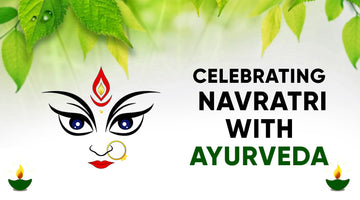
September brings with it the splendor and grandeur of seasonal festivals. People get carried away with the frenzy and joy that surrounds them during this month, enjoying the company of their relatives and peers. Navratri is one such festival, known for its riotous atmosphere. Navratri is an auspicious occasion celebrated over nine days to invoke the spirit of the deity, Goddess, accompanied by a festive mood and the enjoyment of aromatic delicacies. This auspicious occasion occurs during the autumn season and marks the beginning of the season change, the period between summer and winter.
People do not pay much attention to the chilled nip in the air during this time of the month, which becomes their primary reason for falling prey to viral infections and cold flu. Furthermore, the guilty pleasures of gorging on a variety of delicacies served during such occasions, after a full day's fast, cause indigestion and gastric problems.
Navratri, the nine auspicious days, is one of the most anticipated occasions. It represents the triumph of good over evil in religious terms. It is celebrated in various forms throughout India and is very important. The nine auspicious days of Navratri are one of the most anticipated times in Ayurveda. The festival of Navratri marks a change in season and weather. According to Ayurveda, our bodies prepare for the upcoming seasonal shift by balancing our doshas during the nine days of the Navratri festival.
How many times a year is Navratri observed?
The auspicious Navratris are celebrated twice a year:
- Ashwani Navratri in the beginning of winter between September and October,
- Chaitra Navratri at the beginning of summer between March and April.
Navadurga and the significance of each Navratri day Devi is worshipped in nine different forms known as Navadurga. Each day of Navratri is associated with a different manifestation of the Mother Divine.
First Day - Devi Shailaputri
Devi Shailaputri is worshiped on the first day. Devi Parvati is revered as Himalaya Raja's daughter in this form. Shaila means "Extraordinary" or "Achieving Great Heights." Devi's divine consciousness always surges from the highest point. On this first day of Navratri, we worship Devi Shailaputri to achieve the highest state of consciousness.
Second Day - Devi Brahmacharini
Devi Brahmacharini is propitiated on the second day. Devi Brahmacharini is a form of Devi Parvati who underwent severe penance to have Lord Shiva as Her consort. Brahma denotes divine consciousness, and achar denotes behavior. Brahmacharya is defined as a behavior or act that is rooted in divine consciousness. This day is especially sacred for contemplation and exploration of our inner divinity.
Third-Day - Devi Chandraghanta
Devi Parvati assumed the special form of Chandraghata during Her marriage to Lord Shiva. The moon is referred to as Chandra. The moon represents our intellect. The mind is restless and jumps from one thought to the next. Ghanta is a bell that always makes the same sound. The significance is that when our mind is fixed on one point, namely the Divine, our prana (Subtle life force energy) is consolidated, resulting in harmony and peace. This day thus represents withdrawing from all vagaries of the mind and focusing solely on Mother Divine.
Fourth Day - Devi Kushmanda
Mother Divine is worshiped as Devi Kushmanda on the fourth day. Kushmanda translates as "Pumpkin." Ku means small, Ushma means energy, and Anda means egg. Devi's infinitesimal energy manifested the entire universe, which arose from the cosmic egg (Hiranyagarbha). A pumpkin also represents prana because of its unique ability to absorb and radiate prana. It is considered to be one of the most pranic vegetables. On this day, we worship Devi Kushmanda, who bestows Her divine energy on us.
Fifth Day - Devi Skandamata
Skandamata translates as "Mother of Skanda." The motherly aspect of Devi Parvati is worshiped on the fifth day. In this form, she is Lord Karthikeya's mother. She represents maternal love (Vatsalya). Worshiping Devi in this form brings an abundance of wisdom, wealth, power, prosperity, and liberation.
Sixth Day - Devi Katyayani
Devi manifests as Katyayani on the sixth day. It is a form that Mother Divine took in order to destroy the demonic forces in the universe. She was created by the gods' wrath. She is the person who killed Mahishasura. According to our scriptures, anger that promotes dharma (righteousness) is permissible. Devi Katyayani represents the divine principle and form of the Mother Divine who is responsible for natural disasters and calamities. She is the rage that arises in the universe to restore balance. On the sixth day, Devi Katyayani is invoked to put an end to all our inner foes that are impeding our spiritual evolution.
Seventh Day - Devi Kalaratri.
We invoke Devi Kalaratri on the seventh day. Mother Nature is divided into two extremes. One is both frightening and devastating. The other is lovely and peaceful. Devi Kalaratri is a fierce manifestation of Devi. The night is represented by Kalaratri. The night is also regarded as an aspect of Mother Divine because it provides solace, rest, and comfort to our souls. Only at night do we catch a glimpse of infinity in the skies. Devi Kalaratri is the infinite dark energy that contains countless universes.
Eighth Day - Devi Mahagauri
Mahagauri is that which is beautiful, which gives life momentum and freedom. Mahagauri represents Nature's beautiful and serene side. She is the energy that propels our lives while also liberating us. On the eighth day, she is worshiped as Devi.
Ninth Day - Devi Siddhidatri.
We worship Devi Siddhidatri on the ninth day. Siddhi is Sanskrit for "Perfection." Devi Siddhidatri brings about perfection in one's life. She makes the seemingly impossible possible. She takes us beyond the logical mind's constant reasoning to explore the realm beyond time and space.
In this day and age of nuclear families and fast-paced living, many of us celebrate religious holidays even when we are thousands of miles away from our homelands. We do this for a variety of reasons, one of which is to keep the spark of culture alive for our children. AADAR Family hopes you find these extra bits of information useful - some of it you can pass on to future generations, some of it you can keep in the back of your minds, and who knows where or when you will start seeing a transformation in motion!




